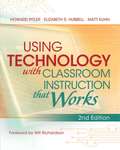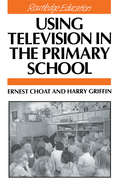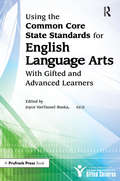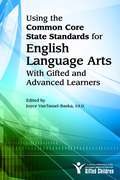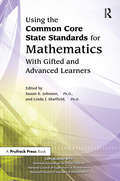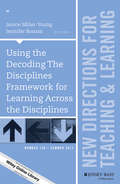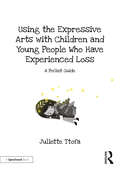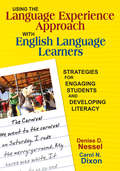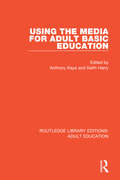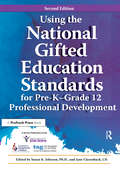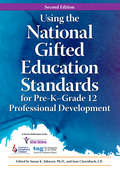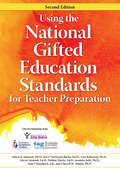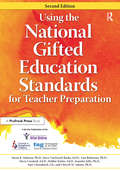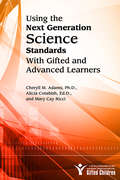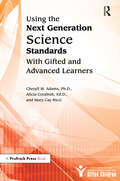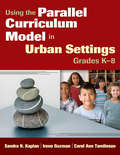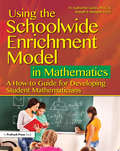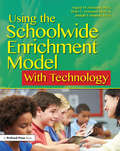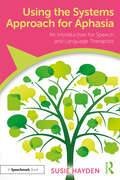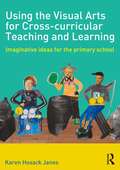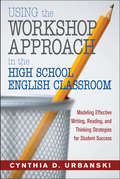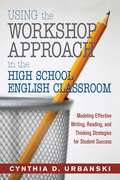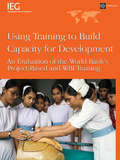- Table View
- List View
Using Technology with Classroom Instruction That Works, 2nd Edition
by Howard Pitler Matt Kuhn Elizabeth R. HubbellTechnology is ubiquitous, and its potential to transform learning is immense. The first edition of Using Technology with Classroom Instruction That Works answered some vital questions about 21st century teaching and learning: What are the best ways to incorporate technology into the curriculum? What kinds of technology will best support particular learning tasks and objectives? How does a teacher ensure that technology use will enhance instruction rather than distract from it?This revised and updated second edition of that best-selling book provides fresh answers to these critical questions, taking into account the enormous technological advances that have occurred since the first edition was published, including the proliferation of social networks, mobile devices, and web-based multimedia tools. It also builds on the up-to-date research and instructional planning framework featured in the new edition of Classroom Instruction That Works, outlining the most appropriate technology applications and resources for all nine categories of effective instructional strategies.
Using Television in the Primary School
by Ernest ChoatLittle attention has been given to the potential of video recorders and cameras in children's learning. This book attempts to counteract such neglect by giving examples of good practice based on classroom experience.
Using the Common Core State Standards for English Language Arts With Gifted and Advanced Learners
by National Assoc For Gifted ChildrenUsing the Common Core State Standards for English Language Arts With Gifted and Advanced Learners provides teachers and administrators examples and strategies to implement the new Common Core State Standards (CCSS) with advanced learners at all stages of development in K-12 schools. The book describes—and demonstrates with specific examples from the CCSS—what effective differentiated activities in English language arts look like for top learners. It shares how educators can provide both rigor and relevance within the new standards as they translate them into meaningful experiences for gifted and advanced learners.
Using the Common Core State Standards for English Language Arts With Gifted and Advanced Learners
by Joyce Vantassel-BaskaUsing the Common Core State Standards in English Language Arts With Gifted and Advanced Learners provides teachers and administrators examples and strategies to implement the new Common Core State Standards (CCSS) with advanced learners at all stages of development in K-12 schools. The book describes--and demonstrates with specific examples from the CCSS--what effective differentiated activities in English language arts look like for top learners. It shares how educators can provide both rigor and relevance within the new standards as they translate them into meaningful experiences for gifted and advanced learners.
Using the Common Core State Standards for Mathematics With Gifted and Advanced Learners
by National Assoc For Gifted Children Linda J. SheffieldUsing the Common Core State Standards for Mathematics With Gifted and Advanced Learners provides teachers and administrators examples and strategies to implement the new Common Core State Standards (CCSS) with advanced learners at all stages of development in K-12 schools. The book describes—and demonstrates with specific examples from the CCSS—what effective differentiated activities in mathematics look like for top learners. It shares how educators can provide rigor within the new standards to allow students to demonstrate higher level thinking, reasoning, problem solving, passion, and inventiveness in mathematics. By doing so, students will develop the skills, habits of mind, and attitudes toward learning needed to reach high levels of competency and creative production in mathematics fields.
Using the Decoding The Disciplines Framework for Learning Across the Disciplines: New Directions for Teaching and Learning, Number 150 (J-B TL Single Issue Teaching and Learning)
by Janice Miller-Young Jennifer BomanDecoding the Disciplines, a program designed to help instructors increase learning in their courses, provides a framework for identifying and remedying course elements that are most problematic for students. Decoding is a seven-step process in which instructors:1. identify a bottleneck of learning, 2. make explicit the mental operations required to overcome the obstacle, 3. model the required steps for students,4. give them practice at these skills, 5. deal with emotional bottlenecks that interfere with learning, 6. assess the success of their efforts, and7. share the results. Providing detailed information so that readers may develop effective models of practice, this volume provides examples and evidence of the ways the framework has been applied across disciplines and used to inform teaching, curriculum, and pedagogical research initiatives. It outlines how various communities of practice got started, describes the analyses of three different collections of Decoding interviews, extends the Decoding framework using different theoretical lenses, and connects the learning to practical applications for teachers and scholars in higher education.This is the 150th volume of this Jossey-Bass higher education series. It offers a comprehensive range of ideas and techniques for improving college teaching based on the experience of seasoned instructors and the latest findings of educational and psychological researchers.
Using the Expressive Arts with Children and Young People Who Have Experienced Loss: A Pocket Guide (Supporting Children and Young People Who Experience Loss)
by Juliette TtofaThis guidebook has been created to be used alongside the storybook, The Girl Who Lost the Light in Her Eyes. Using a relational approach, it explores the themes of the story and offers guidance to the adult as they use expressive arts to give the child or young person a creative outlet for their emotions. The gentle guidance offered makes this an ideal tool for non-specialists working with children experiencing loss or bereavement. It guides the adult to respond appropriately and sensitively to the grief of the child, whilst helping them journey through the grieving process. This book must be used alongside the illustrated storybook, The Girl Who Lost the Light in Her Eyes. Both books are available to purchase as a set, Supporting Children and Young People Who Experience Loss. The full set includes: • The Girl Who Lost the Light in Her Eyes, a colourfully illustrated and sensitively written storybook, designed to encourage conversation and support emotional literacy. • Using the Expressive Arts with Children and Young People Who Experience Loss, a supporting guidebook that explores a relational approach and promotes creative expression as a way through loss or bereavement. Perfectly crafted to spark communication around a difficult topic, this is an invaluable tool for practitioners, educators, parents, and anybody else looking to support a child or young person through loss or bereavement.
Using the Internet in Secondary Schools
by James Hargrave Mike Farmer Eta de CicoWhether a novice or a seasoned surfer, this practical, down-to-earth and straightforward guide should help readers to get to grips with the Internet in all aspects of teaching. It offers practical suggestions for improving the use of the Internet, online resources and ICT in teaching and planning.
Using the Language Experience Approach With English Language Learners: Strategies for Engaging Students and Developing Literacy
by Denise D. Nessel Carol N. DixonPacked with lessons, sample texts, and strategies, this book helps teachers use ELL students' personal experiences to improve their oral language, reading comprehension, and writing skills.
Using the Media for Adult Basic Education (Routledge Library Editions: Adult Education)
by Anthony Kaye And Keith HarryOriginally published in 1982 this volume examines some of the themes and issues involved in the combined use of broadcasting, distance teaching methods and local tutorial or counselling provision for adult basic education. Particular emphasis is laid on identifying means of reaching groups and individuals with special needs in literacy, numeracy and social skills. Detailed case-studies are presented, drawn from the UK, France, Denmark, The Netherlands and Canary Islands.
Using the National Gifted Education Standards for Pre-K - Grade 12 Professional Development
by National Assoc For Gifted Children Jane ClarenbachNational teacher preparation standards in gifted and talented education provide the foundation for research-based practices in gifted education and identify what teachers should know and be able to do to ensure that students with gifts and talents realize their full potential. Because the responsibility for teaching gifted learners and those with potential to achieve at high levels is often shared between gifted education program leaders and teachers in general and special education classrooms, this book shows Pre-K-12 education leaders how to develop partnerships, identify professional development outcomes, design learning activities, plan and implement comprehensive training programs, and evaluate the effectiveness of professional development activities. Special attention is paid to effecting change within a state and school system. Tools provided include sample needs assessments, student and teacher observation instruments, and a sample professional development plan.
Using the National Gifted Education Standards for Pre-KGrade 12 Professional Development
by Susan Johnsen Jane ClarenbachNational teacher preparation standards in gifted and talented education provide the foundation for research-based practices in gifted education and identify what teachers should know and be able to do to ensure that students with gifts and talents realize their full potential. Because the responsibility for teaching gifted learners and those with potential to achieve at high levels is often shared between gifted education program leaders and teachers in general and special education classrooms, this book shows preK-12 education leaders how to develop partnerships, identify professional development outcomes, design learning activities, plan and implement comprehensive training programs, and evaluate the effectiveness of professional development activities. Special attention is paid to effecting change within a state and school system. Tools provided include sample needs assessments, student and teacher observation instruments, and a sample professional development plan.
Using the National Gifted Education Standards for Teacher Preparation
by Cheryll M. Adams Jane Clarenbach Jennifer Jolly Debbie Dailey Alicia Cotabish Ann Robinson Joyce Vantassel-Baska Susan K. JohnsenThis guidebook helps university personnel design or revise teacher preparation courses in gifted education to align with the new standards required by NCATE for program accreditation.
Using the National Gifted Education Standards for Teacher Preparation
by National Assoc For Gifted Children Joyce VanTassel-Baska Ann RobinsonStandards have benefits particular to the field of gifted education. In order to ensure equity and systematic talent search and programming, it is essential that current and future teachers are educated in the relevant theory, research, pedagogy, and management techniques important for developing and sustaining classroom-based opportunities specifically designed for gifted learners. By incorporating the 2013 NAGC/CEC Teacher Preparation Standards in Gifted and Talented Education, this guidebook helps university faculty at the undergraduate and graduate levels design or revise gifted education programs and partner with other educators in developing gifted education teachers.
Using the Next Generation Science Standards With Gifted and Advanced Learners
by Cheryll M. Adams Alicia Cotabish Ed. D. Mary Cay RicciUsing the Next Generation Science Standards With Gifted and Advanced Learners provides teachers and administrators examples and strategies to implement the Next Generation Science Standards (NGSS) with gifted and advanced learners at all stages of development in K?12 schools. The book describes-and demonstrates with specific examples from the NGSS-what effective differentiated activities in science look like for high-ability learners. It shares how educators can provide rigor within the new standards to allow students to demonstrate higher level thinking, reasoning, problem solving, passion, and inventiveness in science. By doing so, students will develop the skills, habits of mind, and attitudes toward learning needed to reach high levels of competency and creative production in science fields.
Using the Next Generation Science Standards With Gifted and Advanced Learners
by Cheryll M. Adams Alicia Cotabish Mary RicciUsing the Next Generation Science Standards With Gifted and Advanced Learners provides teachers and administrators examples and strategies to implement the Next Generation Science Standards (NGSS) with gifted and advanced learners at all stages of development in K-12 schools. The book describes—and demonstrates with specific examples from the NGSS—what effective differentiated activities in science look like for high-ability learners. It shares how educators can provide rigor within the new standards to allow students to demonstrate higher level thinking, reasoning, problem solving, passion, and inventiveness in science. By doing so, students will develop the skills, habits of mind, and attitudes toward learning needed to reach high levels of competency and creative production in science fields.
Using the Parallel Curriculum Model in Urban Settings, Grades K-8
by Sandra N. Kaplan Irene Guzman Dr Carol Ann TomlinsonFeaturing 16 field-tested lesson plans, this book presents a high-quality curriculum that helps urban youth develop key learning skills such as resiliency, self-motivation, and collaboration.
Using the Schoolwide Enrichment Model in Mathematics: A How-To Guide for Developing Student Mathematicians
by M. Katherine Gavin Joseph S. RenzulliUsing the Schoolwide Enrichment Model in Mathematics: A How-to Guide for Developing Student Mathematicians applies the teaching and learning strategies of the Schoolwide Enrichment Model (SEM) to the math classroom. Based on more than 40 years of research and development and used in schools around the world, the SEM approach focuses on promoting higher level thinking skills and creative productivity. Using this approach in mathematics, this new guidebook promotes the use of the Mathematical Practices outlined in the Common Core State Standards as the underlying processes and proficiencies that should be developed in students. Teachers learn how to create a culture of enjoyment, engagement, and enthusiasm for all students, and in particular gifted students, while developing students who think and act like mathematicians. Easy to read and use, the book incorporates many practical suggestions, including views from the classroom and sample activities from NAGC-award winning curriculum to motivate and challenge students.
Using the Schoolwide Enrichment Model With Technology
by Angela Housand Brian Housand Joseph RenzulliUsing the Schoolwide Enrichment Model With Technology is an extension of a talent development model implemented in more than 2,500 schools across the U.S. and widely used internationally. More than 40 years of research and development have documented the effectiveness of the SEM approach to promoting higher level thinking skills and creative productivity. This solution-oriented book, unlike other books focused on using technology in the classroom, recognizes that digital technologies are changing and evolving at lightning speeds. Our effective skills for using technology transcend time by focusing on how to find and use digital resources and tools rather than listing the resources that already exist. Focusing on the skills that support critical thinking and problem solving, decision making, and communication, the authors seamlessly merge technology to launch students toward independent productivity. This accessible and highly practical guide is rich with examples that will change the way you think about education while providing hands-on “how-to” guidance for creating a culture of excellence and innovation in your school and classroom.
Using the Systems Approach for Aphasia: An Introduction for Speech and Language Therapists
by Susie HaydenUsing the Systems Approach for Aphasia introduces therapists to systems theory, exploring the way in which a holistic method that is already a key part of other health and social care settings can be employed in aphasia therapy. Detailed case studies from the author’s own extensive experience demonstrate how systemic tools can be incorporated into practice, offering practical suggestions for service delivery and caseload management in frequently overloaded community health services. Exploring the treatment process from first encounters, through the management of goals and attainments, to caring for patients after therapy has ended, the book demonstrates a method of delivering therapy in a way that will better serve the people who live with aphasia and their families, as well as the clinician themselves. Key features of this book include: • An accessible overview of systems theory and its use in aphasia therapy. • Consideration of how current popular ideas such as self-management, holistic rehabilitation and compassion focussed therapy can be incorporated to provide the best treatment. • Guidance on when and how to involve families based on case studies. • Case studies throughout to fully illustrate systemic approaches. An essential resource for both students and seasoned clinicians, the theory explored in this book will provide a fresh approach to therapy and new skills for working with people with aphasia and their families.
Using the View Camera: Revised Edition
by Steve SimmonsInformation on large-format cameras, their accessories, and films is clearly presented in this updated guide, which covers all the technical aspects of using the view camera.
Using the Visual Arts for Cross-curricular Teaching and Learning: Imaginative ideas for the primary school
by Karen Hosack JanesAs schools are being encouraged to develop more flexible and creative approaches to education, Using the Visual Arts for Cross-curricular Teaching and Learning provides practical guidance and ideas on using the visual arts as a starting point for imaginative, effective learning across a wide range of curriculum subjects. Underpinned by established and current educational thinking, it uses real-life examples to explore how this approach has been used successfully by individual class teachers and as whole-school projects. Offering proven strategies supporting the principles of personalized learning, it will help you involve children in devising cross-curricular themes and setting their own lines of enquiry. Supplemented throughout with case studies and ideas for great artworks to get projects started, as well as examples of children’s own work, it explores: developing individual pupils' talent and respect for their own and other cultures; using a single painting as a starting point for learning in a range of subjects; finding inspiration for your own cross-curricular projects using the visual arts; underpinning all activities with educational purpose; planning for and assessing progression in learning; discovering and using art resources in your region. The tried and tested strategies in Using the Visual Arts for Cross-curricular Teaching and Learning will give all primary school teachers the confidence to explore the benefits of placing the visual arts at the centre of a creative, appealing curriculum.
Using the Workshop Approach in the High School English Classroom: Modeling Effective Writing, Reading, and Thinking Strategies for Student Success
by Cynthia D. UrbanskiTake a peek into an effective workshop-based classroom and discover how you can enhance adolescents' technical and creative abilities in reading, writing, and thinking.
Using the Workshop Approach in the High School English Classroom: Modeling Effective Writing, Reading, and Thinking Strategies for Student Success
by Cynthia D. UrbanskiDo you find that preparing for standardized tests interferes with teaching advanced thinking, reading, and writing skills in a meaningful way? Do you want to balance test preparation with more creative activities? Success in school and beyond depends on one’s ability to read fluently, write coherently, and think critically. This handbook uses the workshop model for exponentially increasing adolescents’ abilities in these three key areas. This practical guide addresses the daily running and practice of a workshop-based classroom, using research and the author’s own experiences to illustrate how to establish a workshop that: Fosters lasting learning while reinforcing the skills needed for standardized tests Teaches audience and purpose as a vehicle to style and structure Provides a supportive and lively environment in which students are comfortable enough to take risks and share original ideas Try Urbanski’s approach to teaching literacy analysis and mentoring student writers, and discover just how rewarding the workshop experience can be!
Using Training to Build Capacity: An Evaluation of the World Bank's Project-based and WBI Training
by World BankThe World Bank finances about US$720 million in training every year, through both its lending projects and its in-house World Bank Institute (WBI). The evaluation found that while most of the training reviewed resulted in demonstrable participant learning, this learning frequently did not lead to real change in participants' workplace performance. Poor training outcomes most often resulted from training content that wasn't relevant to the needs and goals of the target institutions, or from the trainees' lack of incentives or resources to apply learning in their workplaces. These findings highlight how important it is for training to be embedded in broader capacity-building programs that identify and address organizational and institutional capacity constraints alongside human ones.
